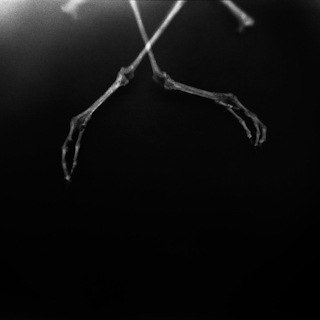Voice: the breath’s tooth.
Thought: the brain’s bone.
Birdsong: an extension
of the beak. Speech:
the antler of the mind.
–Robert Bringhurst,
in Becoming Animal by David Abrams

As the animals go, we go.
The photographs in Remnants are of scientific bird specimens from species (or related species) listed as endangered, threatened, or of special concern in Wisconsin’s Western Coulees and Ridges Ecological Landscape, of which my home county (Dunn) is a part.
One intention in creating these photographs was to become more familiar with endangered and threatened species in the place I inhabit, to “become intimate with [my] home region,” as Scott Russell Sanders writes in his essay, “Homeplace.”
“There is only one world,” Sanders writes, “and we participate in it here and now, in our flesh and our place.”
I fear this world’s demise, with the innocents going first.
These photographs are a contemplation on what we are losing, what will be lost. They are meditations executed with reverence and an intent toward beauty, with hope that our desire for a beautiful world may help us save it.
The actual shooting of the photographs was done with a Holga medium-format film camera, known as a “toy” camera, as it has low-cost construction, a plastic lens, and hardly any control for focus, shutter, or aperture. Taking the photos was very much a meditation: a slow, observational process, involving careful and repeated measurements to estimate focus and composition. Shooting this way allowed me to welcome the accidental and unplanned as partners in the creative process. The texture of film made it an ideal medium for representing the physicality of the specimens in front of me.

Wisconsin Endangered, Threatened, and Special Concern Bird Species,
as designated by the Wisconsin Department of Natural Resources, updated January 2014 (Wisconsin Endangered and Threatened Species Laws & List, dnr.wi.gov):
Wisconsin Endangered
Yellow-throated Warbler (Dendroica dominica)
Peregrine Falcon (Falco peregrinus)
Worm-eating Warbler (Helmitheros vermivorum)
Loggerhead Shrike (Lanius ludovicianus)
Forster’s Tern (Sterna forsteri)
Barn Owl (Tyto alba)
Wisconsin Threatened
Henslow’s Sparrow (Ammodramus henslowii)
Great Egret (Ardea alba)
Red-shouldered Hawk (Buteo lineatus)
Cerulean Warbler (Dendroica cerulean)
Acadian Flycatcher (Empidonax virescens)
Yellow-crowned Night-Heron (Nyctanassa violacea)
Kentucky Warbler (Geothlypis formosa, listed as Oporornis formosus)
Bell’s Vireo (Vireo bellii)
Hooded Warbler (Setophaga citrine, listed as Wilsonia citrina)
Wisconsin Special Concern (15 bird species, those in exhibition listed)
Upland Sandpiper (Bartramia longicauda)
Black Tern (Chlidonia niger)
I would like to thank the Bell Museum of Natural History, University of Minnesota; the University of Wisconsin–Eau Claire; the Milwaukee Public Museum; and the Field Museum of Natural History for allowing me to photograph in their collections.
Images above:
Yellow-throated warbler (Setophaga dominica), Holga 120N, Kodak Ektar 100, 2015. Specimen courtesy of the University of Wisconsin–Eau Claire.
Upper limbs, Forster’s Tern (Sterna forsteri), Holga 120N, Ilford 100 Delta Pro, 2015. Specimen courtesy of the Field Museum of Natural History (FMNH 363455).
Thought: the brain’s bone.
Birdsong: an extension
of the beak. Speech:
the antler of the mind.
–Robert Bringhurst,
in Becoming Animal by David Abrams

As the animals go, we go.
The photographs in Remnants are of scientific bird specimens from species (or related species) listed as endangered, threatened, or of special concern in Wisconsin’s Western Coulees and Ridges Ecological Landscape, of which my home county (Dunn) is a part.
One intention in creating these photographs was to become more familiar with endangered and threatened species in the place I inhabit, to “become intimate with [my] home region,” as Scott Russell Sanders writes in his essay, “Homeplace.”
“There is only one world,” Sanders writes, “and we participate in it here and now, in our flesh and our place.”
I fear this world’s demise, with the innocents going first.
These photographs are a contemplation on what we are losing, what will be lost. They are meditations executed with reverence and an intent toward beauty, with hope that our desire for a beautiful world may help us save it.
The actual shooting of the photographs was done with a Holga medium-format film camera, known as a “toy” camera, as it has low-cost construction, a plastic lens, and hardly any control for focus, shutter, or aperture. Taking the photos was very much a meditation: a slow, observational process, involving careful and repeated measurements to estimate focus and composition. Shooting this way allowed me to welcome the accidental and unplanned as partners in the creative process. The texture of film made it an ideal medium for representing the physicality of the specimens in front of me.

Wisconsin Endangered, Threatened, and Special Concern Bird Species,
as designated by the Wisconsin Department of Natural Resources, updated January 2014 (Wisconsin Endangered and Threatened Species Laws & List, dnr.wi.gov):
Wisconsin Endangered
Yellow-throated Warbler (Dendroica dominica)
Peregrine Falcon (Falco peregrinus)
Worm-eating Warbler (Helmitheros vermivorum)
Loggerhead Shrike (Lanius ludovicianus)
Forster’s Tern (Sterna forsteri)
Barn Owl (Tyto alba)
Wisconsin Threatened
Henslow’s Sparrow (Ammodramus henslowii)
Great Egret (Ardea alba)
Red-shouldered Hawk (Buteo lineatus)
Cerulean Warbler (Dendroica cerulean)
Acadian Flycatcher (Empidonax virescens)
Yellow-crowned Night-Heron (Nyctanassa violacea)
Kentucky Warbler (Geothlypis formosa, listed as Oporornis formosus)
Bell’s Vireo (Vireo bellii)
Hooded Warbler (Setophaga citrine, listed as Wilsonia citrina)
Wisconsin Special Concern (15 bird species, those in exhibition listed)
Upland Sandpiper (Bartramia longicauda)
Black Tern (Chlidonia niger)
I would like to thank the Bell Museum of Natural History, University of Minnesota; the University of Wisconsin–Eau Claire; the Milwaukee Public Museum; and the Field Museum of Natural History for allowing me to photograph in their collections.
Images above:
Yellow-throated warbler (Setophaga dominica), Holga 120N, Kodak Ektar 100, 2015. Specimen courtesy of the University of Wisconsin–Eau Claire.
Upper limbs, Forster’s Tern (Sterna forsteri), Holga 120N, Ilford 100 Delta Pro, 2015. Specimen courtesy of the Field Museum of Natural History (FMNH 363455).